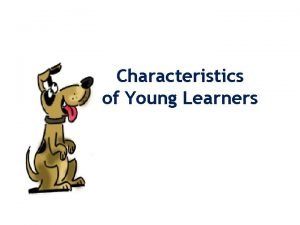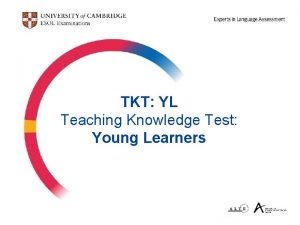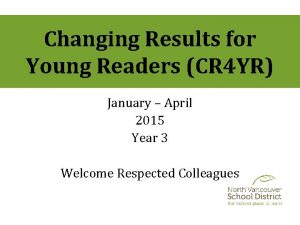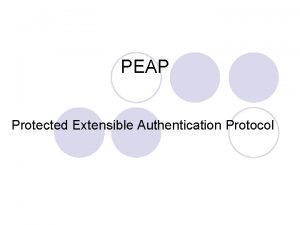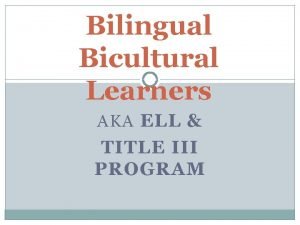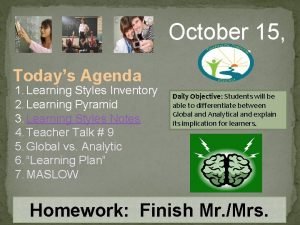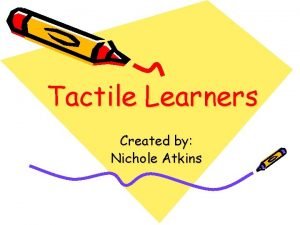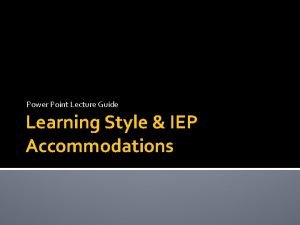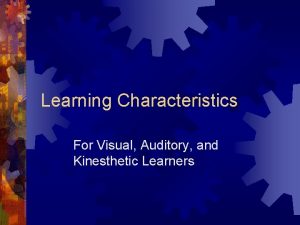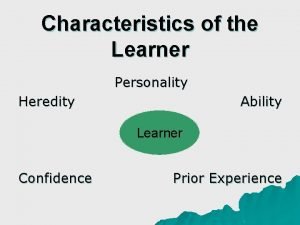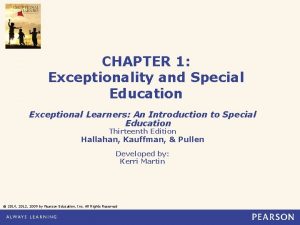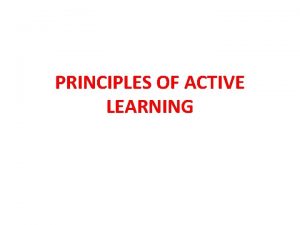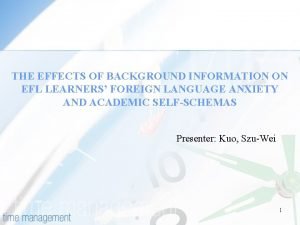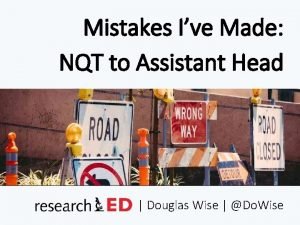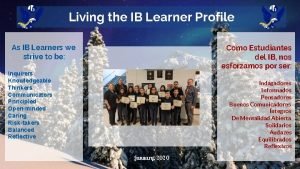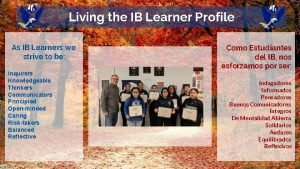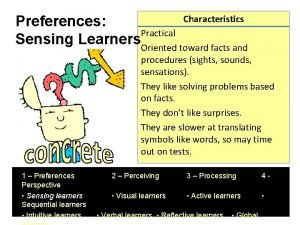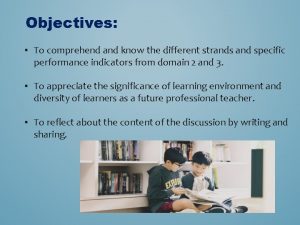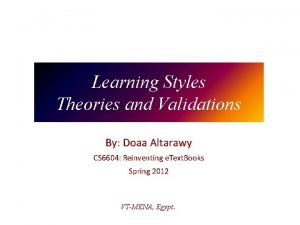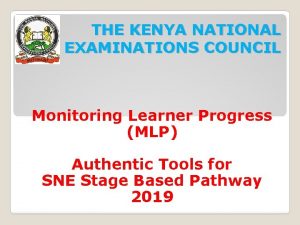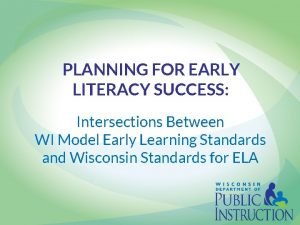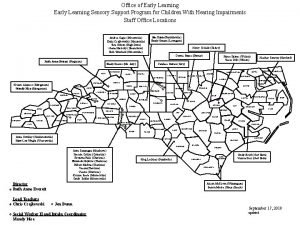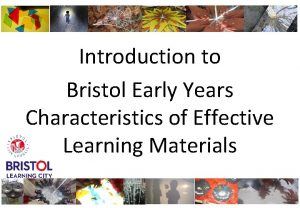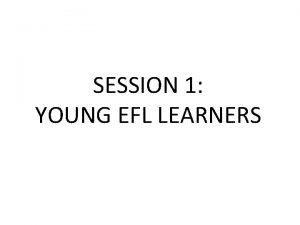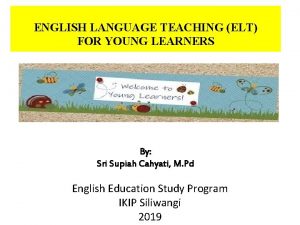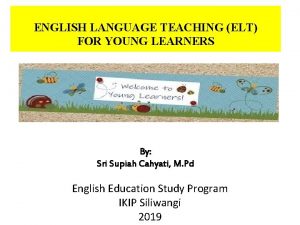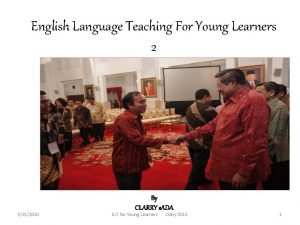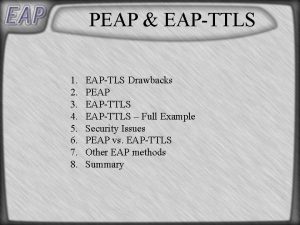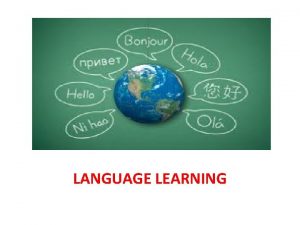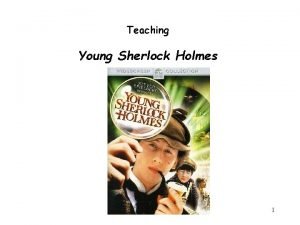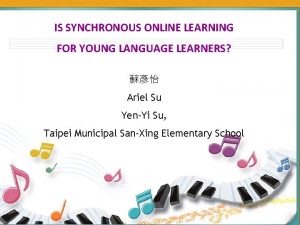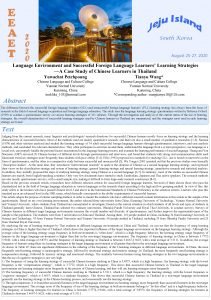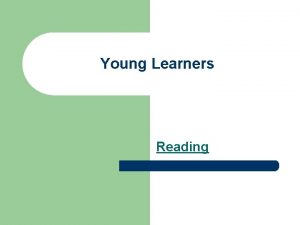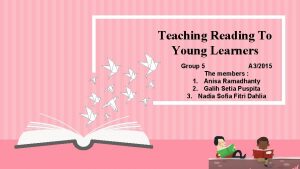Teaching Young Learners from early language learning PEAP




















































- Slides: 52

Teaching Young Learners: ------------------from early language learning( PEAP) to differentiated classroom practices in the multilingual primary context N. Zafeiriades, 2013 1

Before we go ahead, it is necessary to know what is a… l Young Learner (YL) l Very Young Learner (VYL) l A multilingual/ multicultural YL /VYL 2 N. Zafeiriades, 2013

Young learners l short attention spans and a lot of physical energy. l and are more interested in the physical and the tangible. “Their own understanding comes through hands and eyes and ears. The physical world is dominant at all times. ” l Scott and Ytreberg (1990) 3 N. Zafeiriades, 2013

Helpful Ideas for Learning /Teaching to YL/VYL N. Zafeiriades, 2013 4

1. Supplement activities with visuals, realia, and movement. N. Zafeiriades, 2013 5

How? l Create l 6 a“Visuals and Realia Bank” Use Total Physical Response (TPR) by James Asher (1977) N. Zafeiriades, 2013

TPR? l 7 The method relies on the assumption that when learning a second or additional language, language is internalized through a process of code breaking similar to first language development and that the process allows for a long period of listening and developing comprehension prior to production. N. Zafeiriades, 2013

What is TPR? Total Physical Response (TPR) is a method developed by Dr. James J. Asher, a professor emeritus of psychology at Sa José State University, to aid learning second languages. 8 N. Zafeiriades, 2013

l 9 According to Asher, TPR is based on the premise that the human brain has a biological program for acquiring any natural language on earth - including the sign language of the deaf. The process is visible when we observe how infants internalize their first language. N. Zafeiriades, 2013

TPR? l 10 In the classroom the teacher and students take on roles similar to that of the parent and child respectively. Students must respond physically to the words of the teacher. The activity may be a simple game such as ‘Simon Says’ or may involve more complex grammar and more detailed scenarios. N. Zafeiriades, 2013

TPR? Students respond to commands that require physical movement. _____________ What is…. SIMON SAYS? l 11 N. Zafeiriades, 2013

Simon says…. . l 12 A recent psychological study found that the game can be a healthy way to help children to improve self-control and restraint of impulsive behavior. N. Zafeiriades, 2013

Advantages of TPR l l 13 Students will enjoy getting up out of their chairs and moving around. TPR is aptitude-free, working well with a mixed ability class, and with students having various disabilities. N. Zafeiriades, 2013

2. Involve students. n in making visuals and realia for language consolidation (lexis and grammar) n In classroom projects n In storytelling N. Zafeiriades, 2013 14

l Students are more likely to feel interested and invested in the lesson and will probably take better care of the materials Ie. lexis corners Grammar corners classroom wall papers 15 N. Zafeiriades, 2013

ie. arts and crafts for Storytelling…. l 16 For example, if the story is Goldilocks and the Three Bears, you may want to use puppets to help show the action of the story. To get students more excited about the story, have them make little pencil puppets of the three bears and Goldilocks before the storytelling. N. Zafeiriades, 2013

arts and crafts for Storytelling…. l 17 After the storytelling, you can use the puppets to check comprehension of the story plot and have students practice the language by retelling the story using their puppets. N. Zafeiriades, 2013

Collaborate with other subject Ts (ΔΕΠΣ/ ευέλικτη ζώνη) l l l 18 L 1 T Art T Informatics T N. Zafeiriades, 2013

3. follow classroom routines! Classroom management techniques Use available Time and Space wise!! N. Zafeiriades, 2013 19

Move from activity to activity Young learners have short attention spans. For ages 5– 7, Keep activities around 5 and 10 minutes long. For ages 8– 10, keep activities 10 to 15 minutes long. 20 N. Zafeiriades, 2013

Create a balance between the activities in the column on the right /left side. ( Scott and Ytreberg , 1990) l l 21 Quiet/noisy exercises Different skills: listening/talking/reading/writing Individual/ pair work/ group work/ whole class activities Teacher-pupil/ pupil-pupil activities N. Zafeiriades, 2013

Classroom management techniques 4 - vary and enrich your teaching!. Teach in themes. N. Zafeiriades, 2013 22

Ie about water… l 23 A thematic unit, a series of lessons on the same topic or subject, can create broader contexts in which to teach language, recycle language from lesson to lesson. N. Zafeiriades, 2013

Avoid common teacher mistakes…. l 24 Allow students to focus more on content and communication than on language structure. N. Zafeiriades, 2013

5. Enrich your teaching…. . n Use multiple teaching sources however, start from stories and . contexts familiar to students N. Zafeiriades, 2013 25

In our multilingual/ multicultural contexts… l 26 Use of stories and contexts in L 1 country or culture can help YLs connect English with their background knowledge, which is limited because of their young age and inexperience. N. Zafeiriades, 2013

Raise Ss cultural/intercultural awareness l Stories as Culture Bearers -Take a favorite story in the L 1 and transfer it into English l Cultural projects -Allow students a chance to personalize content in every lesson. 27 N. Zafeiriades, 2013

Why Stories? l l l 28 Stories from around the world are excellent to use in classroom, but the teachers also need to use the stories from students’ own culture and heritage. Using local and national stories insure that the students know the background culture and may already know the story. This familiarity lowers the young learners’ stress and reduces anxiety in the classroom. N. Zafeiriades, 2013

All learners, from babies to grandmothers, learn better with stories. l Stories are energizers. l Even hard truths can be taught through stories. l Stories told and read at home and school both entertain and educate young learners. l 29 N. Zafeiriades, 2013

allocate a ‘storytelling day’! l Using stories in the classroom is fun, but the activity should not be considered trivial or frivolous. l Reading or telling stories in a class is a natural way to learn a new language. Stories can also lead to harmony, understanding, and peaceful resolution of conflict. l 30 N. Zafeiriades, 2013

2. Stories as solutions to large classes and limited resources 31 N. Zafeiriades, 2013

l l l 32 In many countries, a shortage of teaching/learning resources is a major constraint. Teachers can use stories to teach language and to introduce other subjects, such as HIV/AIDS problem. Storytelling can enable the teachers to handle large classes of 60 100 pupils even in the absence of books. N. Zafeiriades, 2013

Storytelling day For Speaking Skills 33 N. Zafeiriades, 2013

Storytelling with objects. l l l 34 Use objects such as toys, forks, cups to start the stories. For example, divide the students in the groups of three to five and distribute four to five objects to each group. Ask each of the group to make a story that includes all of their objects. N. Zafeiriades, 2013

Storytelling with pictures. l l 35 Use pictures in the same way as objects were used in the previous activity. Distribute four to five pictures to each group. Make sure each student has one picture. Ask each group to make up a story that includes all the pictures. N. Zafeiriades, 2013

Storytelling day . For Listening Skills 36 N. Zafeiriades, 2013

Storytelling a. b. c. d. 37 Read or tell simple stories to the students. You can use pictures or small objects. After initial storytelling, ask the learners tell the story. This technique is the most effective if it involve several students. Choose one person to re-tell the story, then ask others to continue the story. Let all the students tell the story unless it is finished. In short, let each student tell two or three sentences of the story. N. Zafeiriades, 2013

Storytelling day For Reading and just for pleasure…. . www. nfb. ca/playlist/kids-cartoons Cartoons for Kids - National Film Board of Canada 38 N. Zafeiriades, 2013

l l 39 Find an easy version of story that the children can read. Read the story aloud the first time, or let the readers read it silently. let Ss enjoy reading and do things with the story……. ( draw, paint, dramatise, sing , create a crafts book …rap… with it. ) N. Zafeiriades, 2013

Storytelling day For Writing 40 N. Zafeiriades, 2013

41 l Have the learners draw or paint a scene from a story and then write at least one line from the story under the picture. l Create a a variation or let Ss make up a brand new story …. . N. Zafeiriades, 2013

Establish classroom routines in English. N. Zafeiriades, 2013 42

l 43 YLs function well within a structured environment and enjoy repetition of certain routines and activities. Having basic routines in the classroom can help to manage young learners. N. Zafeiriades, 2013

Use L 1 as a resource when necessary _______________ • Concentrate on building communicative skills. • Use L 1 in the classroom as a resource forwarding the learning process without becoming too reliant on it. N. Zafeiriades, 2013 44

Collaborate with other teachers in your school. N. Zafeiriades, 2013 45

l 46 Connect your lessons to the topics, activities and stories your students are learning in their native language by planning related thematic units that parallel the learning in other subjects. N. Zafeiriades, 2013

Peer teaching helps!! l 47 Visit other teachers’ classrooms can be wonderful way to get to know what is being learnt in each others’ classes and how. N. Zafeiriades, 2013

Communicate with other TEYL professionals. N. Zafeiriades, 2013 48

Connect to T- learning communities l Along with collaborating with the other teachers at your school, it is important to keep in touch with other TEYL professionals, both in your local area and internationally. 49 N. Zafeiriades, 2013

Teacher development… an ongoing and lifelong process. . is 50 N. Zafeiriades, 2013

and always keep in mind: You are a teacher of young learners and learning must be fun!! N. Zafeiriades, 2013 51

Thank You!!! N. Zafeiriades, 2013 52
 Grammar examples
Grammar examples Teaching young learners english
Teaching young learners english Involuntary attention meaning
Involuntary attention meaning Tkt young learners book
Tkt young learners book Changing results for young learners
Changing results for young learners Fairlie primary
Fairlie primary Define peap
Define peap Definition of remedial teaching
Definition of remedial teaching Assistive technology for english language learners
Assistive technology for english language learners English language learners
English language learners Reading strategies for english language learners
Reading strategies for english language learners Cr part 154
Cr part 154 Developmental sequence in language acquisition
Developmental sequence in language acquisition Early childhood is __________ for language learning
Early childhood is __________ for language learning Early cpr and early defibrillation can: *
Early cpr and early defibrillation can: * Cuadro comparativo entre e-learning b-learning y m-learning
Cuadro comparativo entre e-learning b-learning y m-learning Phases of microteaching
Phases of microteaching Language acquisition vs language learning
Language acquisition vs language learning What is the language in
What is the language in Global vs analytical learners
Global vs analytical learners Tactile learner definition
Tactile learner definition Global vs analytical learners
Global vs analytical learners Kinesthetic learners characteristics
Kinesthetic learners characteristics Lazy and eager learning in machine learning
Lazy and eager learning in machine learning Kinesthetic learning
Kinesthetic learning When is cognitivism beneficial for learners
When is cognitivism beneficial for learners What is global-analytic continuum
What is global-analytic continuum Code of conduct for teachers 2019
Code of conduct for teachers 2019 Inheritance characteristics
Inheritance characteristics Exceptional learners: an introduction to special education
Exceptional learners: an introduction to special education Principles of active learning
Principles of active learning Questioning strategies to engage all learners
Questioning strategies to engage all learners Background information for learners
Background information for learners Quadrant d
Quadrant d Government program for gifted students in the philippines
Government program for gifted students in the philippines Famous people with naturalist intelligence
Famous people with naturalist intelligence Learners will be able to
Learners will be able to Graham nuttall the hidden lives of learners
Graham nuttall the hidden lives of learners Inquirer ib profile
Inquirer ib profile Ib learners profile
Ib learners profile Sensing learners characteristics
Sensing learners characteristics Technology for diverse learners
Technology for diverse learners Passive learning vs active learning
Passive learning vs active learning Diversity of learners
Diversity of learners Impulsive learners
Impulsive learners Knec mlp
Knec mlp How good is our early learning and childcare
How good is our early learning and childcare Wmels domains
Wmels domains Oregon early learning and kindergarten guidelines
Oregon early learning and kindergarten guidelines Early learning sensory support program
Early learning sensory support program Stages of early arithmetical learning
Stages of early arithmetical learning Mullen scales of early learning
Mullen scales of early learning Bristol characteristics of effective learning
Bristol characteristics of effective learning


